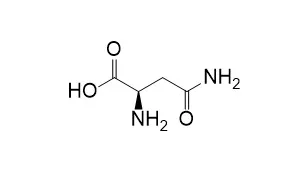| In vitro: |
| Biologia Plantarum, 1995, 37(2):305-308. | | NaCl stress in rice seedlings: effects of L-proline, glycinebetaine, L-and D-asparagine on seedling growth.[Reference: WebLink] |
METHODS AND RESULTS:
The effect of L-proline, glycinebetaine, L- asparagine and D-Asparagine on rice seedling growth under NaCl stress was investigated.
CONCLUSIONS:
Glycinebetaine and L-asparagine were not effective in reducing NaCl inhibition in shoot growth of rice seedlings. L-Proline and D-Asparagine were found to be able to reduce shoot growth inhibition under NaCl stress. However, L-proline, glycinebetaine, D-Asparagine and L-asparagine further enhanced NaCl inhibition of root growth. | | Journal of Food ence & Nutrition, 2008, 13(3):182-189. | | The Effect of pH on the Antioxidative Activity of Melanoidins Formed from Glucose and Fructose with L and D-Asparagine in the Maillard Reaction.[Reference: WebLink] |
METHODS AND RESULTS:
In this study, the effect of pH on the antioxidative activities of melanoidins formed as a result of the reaction between sugars, glucose (Glc) or fructose (Fru), and amino acids, L-asparagine (L-Asn) and D-Asparagine (D-Asn) are examined. For this purpose, antioxidative activities were evaluated on the basis of reducing power, including ferric reducing/antioxidant power (FRAP) and free radical scavenging activity includes 1,1-diphenyl-2-picryl- hydrazil (DPPH) and 2,2'-azinobis(3-ethylbenothiazoline-6-sulfonic acid) diammonium salt (ABTS) and ferrous ion chelating activity. Ethylene diamine tetraacetate (EDTA) and trolox, a water-soluble analog of tocopherol, were used as reference antioxidant compounds. The antioxidative activities of the melanoidins at a pH of 7.0 were greater than those with a pHs of 4.0 and pH 10.0.
CONCLUSIONS:
Especially, it was found that the melanoidins formed from D-isomers are more effective antioxidants in different in vitro assays. The reducing power and chelating activity of the melanoidins formed from the Fru systems were higher than those of the melanoidins formed from the Glc systems. However, the ABTS radical scavenging activity of the melanoidins formed from the Glc systems were higher than those of the melanoidins formed from the Fru systems. In particular, the DPPH radical scavenging activity and the FRAP of the melanoidins showed different antioxidative activities according to pH level. |
|






 Cell. 2018 Jan 11;172(1-2):249-261.e12. doi: 10.1016/j.cell.2017.12.019.IF=36.216(2019)
Cell. 2018 Jan 11;172(1-2):249-261.e12. doi: 10.1016/j.cell.2017.12.019.IF=36.216(2019) Cell Metab. 2020 Mar 3;31(3):534-548.e5. doi: 10.1016/j.cmet.2020.01.002.IF=22.415(2019)
Cell Metab. 2020 Mar 3;31(3):534-548.e5. doi: 10.1016/j.cmet.2020.01.002.IF=22.415(2019) Mol Cell. 2017 Nov 16;68(4):673-685.e6. doi: 10.1016/j.molcel.2017.10.022.IF=14.548(2019)
Mol Cell. 2017 Nov 16;68(4):673-685.e6. doi: 10.1016/j.molcel.2017.10.022.IF=14.548(2019)